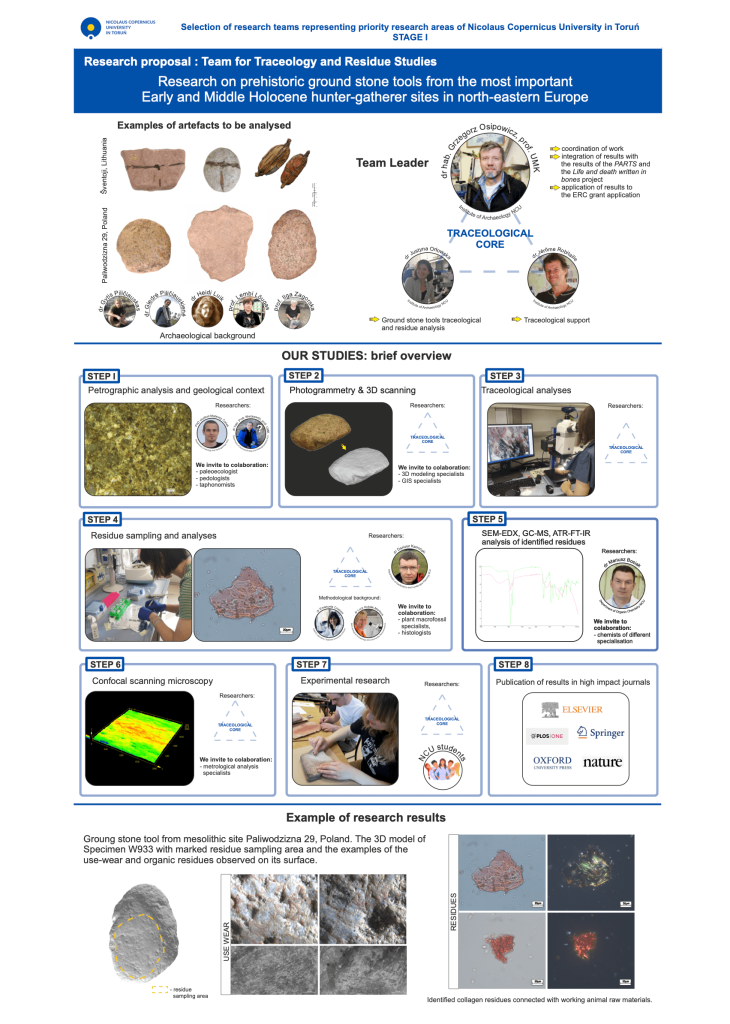Project Leader: Dr. Grzegorz Osipowicz, PhD, UMK
The aim of the project is to build comprehensive knowledge on the production and use of artifacts made from stone, bone (including antler and animal teeth), and plant materials among hunter-gatherer-fisher communities (Mesolithic and sub-Neolithic) inhabiting the East Baltic Plain (areas of Lithuania, Latvia, Estonia, and northeastern Poland) during the Early and Middle Holocene. The study area is unique not only due to the discovery of exceptionally well-preserved and securely dated organic raw material sources from the Stone Age, but also because throughout the Early and Middle Holocene (i.e., approximately 11,600 to 4,000–5,000 years ago) it was situated at the boundary between two worlds: Eastern and Western Europe, as well as between hunter-gatherers and farmers, transmitting and absorbing ideas from both. Therefore, it provides an ideal setting to study the intensity, characteristics, and profile of cultural changes in Early and Middle Holocene hunter-gatherer communities influenced by impulses from the emerging Neolithic (early farming) environment.
The research conducted in this project will constitute the third stage of studies carried out within two international research projects funded by the National Science Centre in Kraków, namely Life and Death Written in Bones: The Technological and Functional Aspect of the Osseous Artifacts of Early and Middle Holocene Hunter-Gatherer-Fisher Communities Inhabiting the East Baltic Plain (https://biotrapbones.umk.pl/) and PlAnt Raw maTerialS in the Life of Middle Holocene Hunter-Gatherer-Fisher Communities of the Southeastern Coast of the Baltic Sea (PARTS project) (https://partsproject.umk.pl/). In addition to continuing extensive studies on organic material artifacts conducted in these grant projects, the proposed research program aims to address the cultural and functional significance of so-called macrolithic stone tools for the studied hunter-gatherer groups. These highly interesting artifacts, made from coarse-crystalline rocks, have recently attracted the attention of leading traceology laboratories worldwide due to their potential to preserve residues—remnants of materials processed using these tools.
Macrolithic tools are typical of early farming communities, where they were commonly used, for example, to grind cereal grains; however, their role in hunter-gatherer groups remains unclear (until recently, it was even assumed that such tools were not used by these groups).
In the proposed research project, we aim to conduct multidisciplinary studies, particularly specialized morphometric, raw material, and traceological analyses (including residue analysis) of macrolithic stone tools from key Early and Middle Holocene archaeological sites in northeastern Europe, namely Kunda Lammasmägi, Pulli, and Narva in Estonia; Zvejnieki and Lake Lubana in Latvia; Šventoji, Garnys, Kaltanėnai, Žemaitiškė II, and Kretuonas 1C in Lithuania; as well as Paliwodzizna 29 and Ludowice 6 in Poland.
The traceological analyses conducted as part of the project, combined with residue studies using optical, metallographic, confocal, and SEM microscopes, will be coordinated with physico-chemical and paleobiological studies employing research tools such as micro-CT, OCT, ZooMS, GC-MS, FTIR, and EDX.

